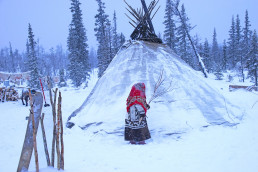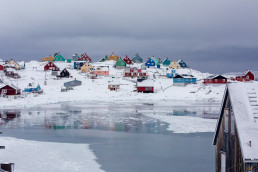Part of the Arctic Opportunity Explorer Challenge
The Arctic is a unique, fragile, and highly threatened environment with isolated communities and limited infrastructure. In communities across the region, two of the greatest challenges for sustainable development are good health and well-being and gender equality — both of which are also enshrined in the UN Sustainable Development Goals (SDGs) and entwined with other aspects of sustainable development. With slow progress and climate change threatening to accelerate existing risks, we believe that only student entrepreneurs armed with digital collaboration tools can thaw the frozen challenges in these communities.
Digital collaboration and sustainable entrepreneurship techniques form the core approach of the Arctic Opportunity Explorer challenge, a programme led by Sustainia and HelloScience in collaboration with six universities and supported by the Nordic Council of Ministers.
But why focus on student entrepreneurship? Because the future of the Arctic is too important to leave to the adults.
Students are the future. Whichever way you look at it, students are important because they are the next generation of society. They will be the next business leaders, policy makers, consumers, travellers, mothers, fathers… Everything. That means that what they think and do makes a difference. Quite a big difference in fact. And from what we have seen over the past few years, especially in the EU and US, it seems like this generation is not happy to sit back and accept the status quo… Students of today have a desire to tackle the big issues. They are also the children of the exponential age — surrounded by technology from a young age and no stranger to change or new approaches.

Today’s youth have an intrinsic desire to tackle the big issues
If the ages between 0 and 8 are the formative years, the ages towards adulthood could be described as the normative years. Here is when young people have the choice to accept the status quo and adopt existing behaviours, or to disrupt. We are seeing again and again that when presented with the facts and future predictions, students do not accept business as usual.
Greta Thunderg first learned about climate change in 2011, when she was eight, and could not understand why not more was being done about it. At eleven years old she became depressed and stopped eating for months. At fifteen she decided she would not accept the status quo, and began her ‘Skolstrejk för klimatet’ or school strikes for the climate. She has since inspired millions of others around the world to do the same. The Greta effect has taken hold, and shown young people that they can make a difference. Without the habitual behaviours learned over years of life and the nagging lens of ‘reality’, the youth have a much stronger belief that change is both possible and required.
Greta is just one of the hundreds of thousands of other young people that have joined the strikes for climate, highlighting to governments around the world that for them, climate change is a key issue. It is reflected in generational surveys too, with Deloitte’s most recent highlighting that for Gen Z and Millennials, climate change is the top issue of concern. Furthermore, when it comes to global issues (including, but not limited to, climate change), half of respondents from one survey show that both Millennials and Gen Z believe that they as individuals can be the greatest agents of change.
An education in entrepreneurship
So students have the desire to make change, and there is an increasing demand to provide students with the skills and knowledge to be active in entrepreneurship. No longer is entrepreneurship limited to starting a business ‘out of the back of a van’. Programmes, courses, conferences, projects, and camps have been created in universities all over the world to educate young people in techniques and frameworks for innovation and entrepreneurship. These classes are being offered in a broad range of disciplines too, as universities increasingly aim to be hubs for exciting business ideas.

Entrepreneurship can be a tool for social impact
As innovation and entrepreneurship education continues to develop, there is also an increasing focus on how to build in sustainability into the picture. As many young innovators want to use entrepreneurship as a vehicle for social impact, guiding frameworks are re-examining the take-make-waste approaches of old and offering new sustainable business models. One example is the abundance cycle framework, developed by Jay Friedlander at the College of the Atlantic in Maine. His framework incorporates social, environmental, as well as financial aspects (commonly referred to as the three Ps: People, Planet and Profit) and provides an operational approach for working with sustainable entrepreneurship. Jay presented the Abundance Cycle Framework at one of the Arctic Opportunity Explorer workshops, showing the students how to incorporate sustainability into the very heart of their ideas.
There have been many fantastic examples of sustainable entrepreneurship from young people, some of which feature on Sustainia’s Global Opportunity Explorer. Boyan Slat, for example, was just 18 when he came up with the idea of creating a device to remove 90% of the world’s ocean plastic. Eight years and many iterations later, The Ocean Cleanup project is getting closer to becoming a viable solution to cleaning up some of the trash that is clogging up the oceans. Ann Makosinki is another young social entrepreneur. In 2014, Ann won the Google Science Fair with Hollow Flashlight, a thermoelectric flashlight that can help provide affordable lighting solutions for rural and offgrid communities.
COVID-19 has changed everything
The global pandemic has taken its toll on many aspects of life. With a vaccine still some way off, people and governments are still working out how to balance life with safety and protecting people’s health. Technology has been one saving grace during these times that has allowed continued interaction between isolated individuals and communities, as well as show the potential of remote working. It is therefore perfect timing for technology to enable greater collaboration in student entrepreneurship. During the Arctic Opportunity Explorers programme, we will be using Novozyme’s digital collaboration tool Hello Science to enable students from more than six universities to work collaboratively together, across timezones and continents. As well as seeking the well-described benefits of diversity on innovation potential, this type of digital collaboration will set the students up well for later working life, whether as entrepreneurs or as part of larger workforces where it will be part fo the new normal.
Overall, the challenges of gender inequality and good health and well-being in the Arctic are both challenges of immense scale, nuance, and history. Breaking them down will require a special approach, one that we believe can only be achieved by younger generations with their novel combination of motivation, capabilities, and collaboration.